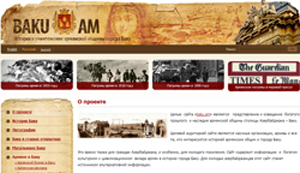
The presentation of www.baku.am website took place in “Picasso Hall” of Congress Hotel on February 23, at 12.00.
The Armenian Genocide Museum-Institute has initiated and presents a unique trilingual website covering the social, political, cultural and business life of the Armenian community in Baku. Hundreds of photographs, illustrations and post cards demonstrate the history of Armenian families, Armenian buildings, and Armenian press issued in Baku, publishing, advertisements and generally the history of Armenian cultural existence in Baku.
Separate section is dedicated to photographs and documents covering the Armenian massacres of 1905, 1918 and 1990 in Baku.
The Armenian community in Baku fell victim to the genocide which was well planed by Azerbaijani and Turkish authorities and carried out in three stages. As a result, the Armenian element that made great contribution to the history of development of Baku city ceased to exist.
At the beginning of the 20th century Baku as a large industrial center in the Transcaucasia region of Russian Empire had rich Armenian civilizational presence. The Armenians were the third large ethnic group after the Russians and multi-tribal Muslim population in the city. Nevertheless, Armenians had leading role in social, industrial and cultural life of the city. Due to the Armenian businessmen activities Baku oil industry ran up.
The buildings constructed with the support of the Armenian businessmen and designed by talented Armenian architects in European architectural best traditions and styles so far decorate Baku, the capital city of Azerbaijan. The official anti-Armenian policy of Azerbaijani authorities doesn’t tolerate any mentioning of the Armenian existence in Baku and of their great contribution to the history of the city.
Creation of the website is a special tribute of respect to the memory of Armenians in Baku who fell victim to state orchestrated policy of intolerance and xenophobia provoked against Armenians in Azerbaijan.
The website was initiated and accomplished by the Armenian Genocide Museum-Institute.





